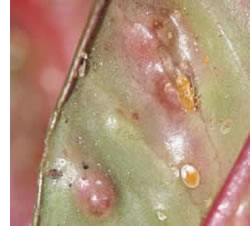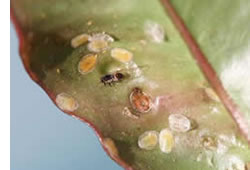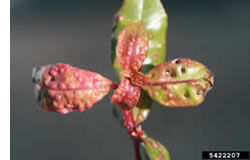NEWS ARTICLE ARCHIVESDo Your Syzygium's Have Zits? Advice from Downes Wholesale NurseryOne of the most common pests affecting Syzygium species is the Pimple psyllid (Trioza eugeniae).
The adults are small sap sucking insects about 2-4mm long (pictured). After mating the female psyllid inserts yellow oval shaped egg into the edge of new leaves. Small nymphs hatch from the eggs and move to the newly expanding leaves, where they feed and develop in pimple or cup shaped pit or gall which is formed by the plant's response to the psyllids feeding. Excessive pit formation creates severely distorted or blistered leaves leaving shoots to appear stunted. Nymphs produce excrement in the form of tiny white pellets, some of which collects on foliage and becomes blackened from sooty mould growth. When mature the nymphs transform into winged adults.
Psyllids affect a wide range of Syzygium and Waterhousea species, they prefer plants with a softer leaf surface that they can penetrate which is why species like Acmena are not affected. Not all Syzygium's are susceptible, Syzygium luehmannii is not affected and a lot of the cultivars available are resistant to them. Health also has a lot to do with it plants that are stressed and in poor condition are far more susceptible to attack, when I was building a house about 5 years ago I planted a 25lt lily pilly in the backyard that quickly became unhealthy with all the builders activity and neglect and I don't think there was one leaf that was not pimpled, I sprayed it once and nursed it back to health. The plant is now 6 metres tall and I have not seen a pimple on it since. Syzygium paniculatum is probably the worst affected species I think. I still recommend planting Syzygium species as they are gorgeous plants and most of the time are hardly affected as long as you keep your plants healthy. We stick with the more resitant species here, our helpful sales staff can advise you further if needed. Some areas are more prone to attack so you may need to select your Syzygium species a little more carefully.
So how do we deal with the pesky little pest's. When you see the damage it's generally too late the damage can't be reversed. If it's a mild attack it's not really going to affect the health of the plant just make it look a little ugly, spray with white oil and either Confidor or Rogor which are systemic insecticides this will kill the nymphs, (Systemic sprays are chemicals that will travel through the plant and remain in the plant tissue for a period of time). If it's a severe attack it's a good idea to prune the damage out spray with White oil and Confidor or Rogor and feed the plant as well as treat with Seasol to improve the health. They prefer mild temperatures so are less prevalent in the heat of summer and cold winters. If you have any questions or simply need a competitive quote please let me know.
Cheers Images courtesy Whitney Cranshaw, Colorado State University, Bugwood.org |
 |
 |
 What are psyllids?
What are psyllids?
 What do they like?
What do they like?
 Let's go to war.
Let's go to war.